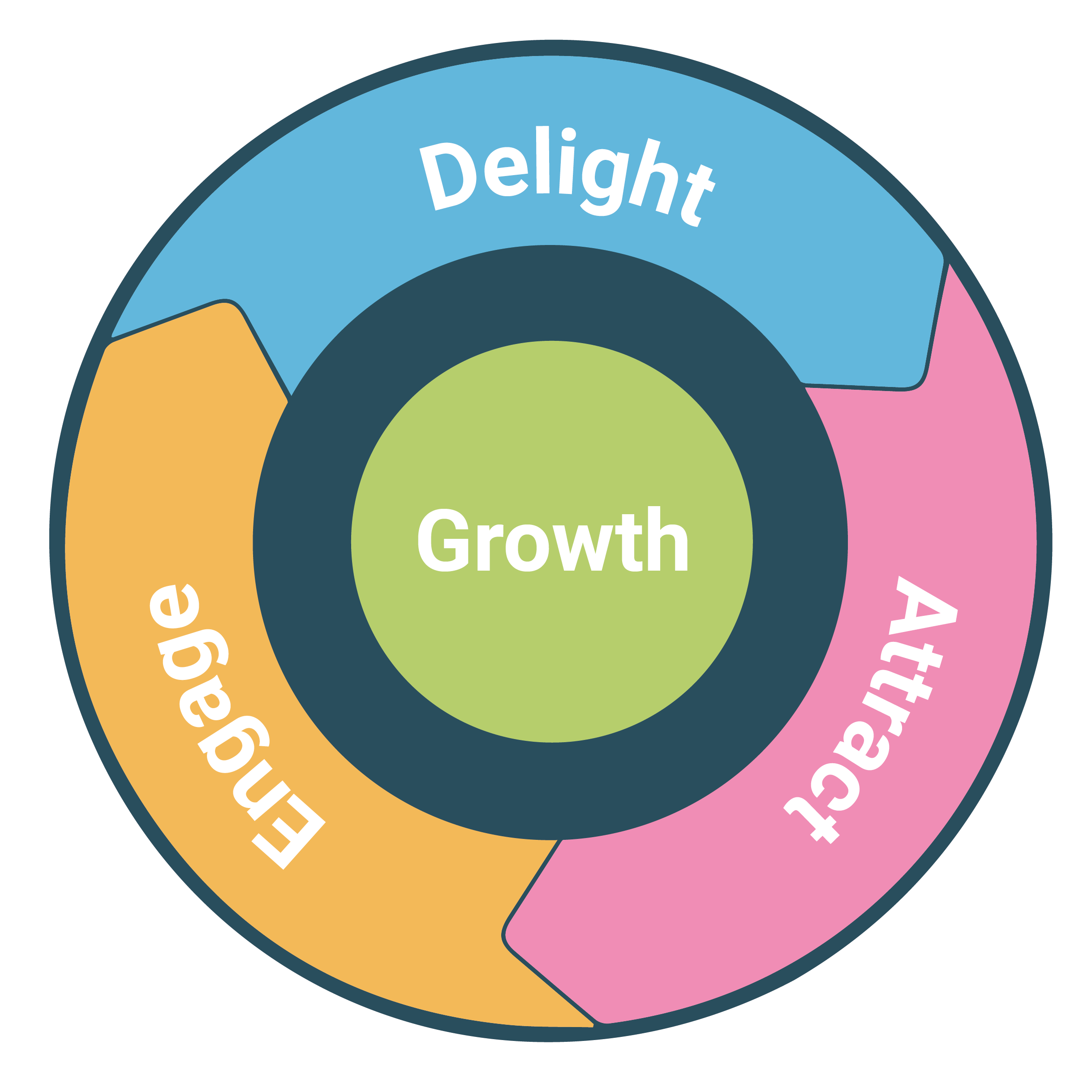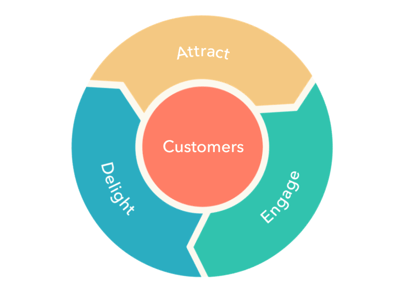
Get weekly
HubSpot updates
The inbound way is centred around 3 words: Attract. Engage. Delight.
For some people, “Abracadabra” or “Would you like a glass of wine?” are the magic words. For those applying the inbound marketing philosophy to their business, it’s “Attract. Engage. Delight.” Everything you do – from how you conduct phone calls, to writing your blog or emails and face-to-face interactions – centres around these three verbs. To grow your business and sell to customers, first you must attract them, engage them, then delight them. As HubSpot puts it:
“Inbound is a method of attracting, engaging, and delighting people to grow a business that provides value and builds trust… Inbound is a better way to market, a better way to sell, and a better way to serve your customers. Because when good-for-the-customer means good-for-the-business, your company can grow better over the long term.”
Here, we offer a quick self-assessment quiz for you to work out just how inbound your business is and offer a few tips to help you make some basic changes to your processes to help you grow better. But first, a little insight into why the inbound methodology is a flywheel. (Already practicing inbound marketing and want to skip to the quiz? Click here).
What is the inbound flywheel?
At Inbound 2018, HubSpot’s annual marketing conference, HubSpot’s Co-Founder and CEO Brian Halligan introduced the idea of the marketing flywheel.
Essentially, the purpose of the flywheel is to put the customer – and their experience with your business – at the centre of every action, from stranger to customer. Instead of a linear, downwards-pointing funnel with a clear beginning and end, the flywheel operates in a circular, repeatable way, meaning that once a customer reaches the “end” of the journey by being delighted, they will help you to attract new customers.

The three stages of inbound marketing in more detail:
Attract: Offer help, support or a solution to a problem your typical customer has. Build trust with them by showing you understand them and want to help. In short, add value before you extract value.
Engage: Once you’ve attracted a prospect, you need to show you’ve more substance and expertise that can help them to build credibility: you aren’t a one-trick pony. Importantly, you need to make it easy for prospects to buy.
Delight: Once your prospect is engaged with you and your business, it’s time to delight them to build momentum – go beyond what is expected of you. Your customers’ success is your success.
The difference between the inbound marketing funnel and the inbound flywheel
Here, Arsham Mirshah of WebMechanix explains the change between now (the flywheel) and then (the funnel) in more detail:
No longer will we be focusing on the funnel – an outdated model which sees businesses squeezing their prospects through one stage to another until they reach the bottom, as a fully formed customer. Instead, we will create and maintain a customer-centric experience, putting them at the heart of each stage in their cyclic journey: the inbound flywheel. Customers are not an output, they fuel your business growth.
Force & Friction In The Flywheel
The two forces behind the flywheel's success can be categorised under "force" - actions, events, behaviours - that drive the flywheel, and "friction" - limiting or inhibiting factors. The force and momentum created by your satisfied clients and customers keeps the flywheel (and your business) spinning.
Force examples include: customer success stories (testimonials), referrals, repeat sales, SMART content
Friction examples include: poor lead quality and/or lead nurturing and misaligned marketing and sales teams.
Along with this updated model, HubSpot – whom ESM Inbound offers onboarding, coaching, training and website design/migration services on behalf of – has upgraded its software. This means marketing, sales and services are more clearly aligned and shows HubSpot has been listening to customer feedback, providing them with better tools in order to better help our own customers.
Are you practising Inbound?
Many of us like to think we are applying the inbound methodology to our businesses, but how can we be sure? Like the muscles in our body, inbound has to be constantly retrained, challenged and recalibrated in your marketing output, or it becomes less effective. Here are eight questions to ask yourself to judge just how inbound you really are:
1. Have you identified your ideal buyer personas?
In order to attract your prospects in the first place, you need to understand them. Who are they? Age? Job title? Family life? What do they worry about? What do they spend their money on? To build the most thorough picture of your customer means interviewing current and past ones – this takes time but will pay dividends when you are able to accurately target the people you really want to be starting conversations with.
2. Are these personas at the centre of everything you create?
Do you ever write content only to consider later on who it might actually be aimed at? Do you ever create brilliant resources, social media posts, blogs and emails, only to find no one is accessing them? Just because you enjoyed making it doesn’t mean your customers will enjoy reading/watching it if you don’t put them at the heart of your content.
3. Do you research prospects before calling them?
To really reach your prospects, you need to speak to them on a human level; find the things you share. By reading a couple of their blog posts, checking out their LinkedIn profile and giving their website a look over, you’ll feel better prepared to talk to them and it’ll show that you’ve done your research, and you care.
4. Do you add value before you extract value?
The ‘Give-get’ model is all about giving prospects something before you get anything in return. This illustrates the inbound method perfectly as it shows a potential customer that you want to help, extending knowledge and advice to them. If you notice their CTA could be working harder or a sidebar could be better worded – tell them and offer to help, expecting nothing in return.
5. Would current customers say they feel valued by you?
One of the most powerful questions inbound organisations can ask themselves is: if asked tomorrow, would your existing customers or clients re-purchase/sign another contract with you? How do you know? Do you ask customers and clients how happy they are? There’s no point in adding new customers if your current ones aren’t feeling delighted.
6. Are you an information hub, ready to help prospects with their problems?
Do you relish helping and educating others? You’ve got to where you are because you’re an expert at something, whether this is the education system, organic vegetables or swimming pools. But how do you use this knowledge? Do you create guides, blog posts and emails to help your customers, or do you enjoy being the gatekeeper of wisdom, keeping it to yourself until someone pays you?
7. Do you know facts about your customers and their goals?
Which of your clients recently became a parent? Which one really wants to go on a trip to Bali? It doesn’t matter how big or small, if you remember events in your customers’ lives and their personal goals (or, at least, save that data in your CRM), as well as business goals, showing an interest in them as people, not only is this the inbound thing to do, but it’s a human-to-human act. This shows what’s truly at the heart of your business.
8. Have you got contacts in the wider industry who you work with?
Do you reach out to old colleagues? What about people you meet at conferences and training days? Do you add people to your LinkedIn profile? Keeping on good terms with people in the industry – and offering to help them – is a sure sign you’re working in an inbound way. Collaborating with these contacts works as a two-way benefit, too: you can create materials that act as positive endorsement for both of you.

How did you do?
What score did you give yourself out of eight? If you’re doing almost all these things – bravo! You’ve got inbound ingrained in your way of thinking and your business model. Now it’s time to consider if you’re applying the flywheel to your marketing, sales and service practices. Are you constantly repeating the process in a cycle, asking yourself if customers and clients are attracted, engaged and delighted, before starting again?
If you feel like some of the points above are missing from your business, there’s no time like the present to try something new. The beauty of inbound is that it often doesn’t take a giant overhaul of your methods, but just a few tweaks to set yourselves back on track. Reach out to people – whether it’s customers or peers – ask how they are, if they’re happy, or if they want to collaborate. Keep communication channels open and remember to always be striving to help and educate – the rest will follow.

